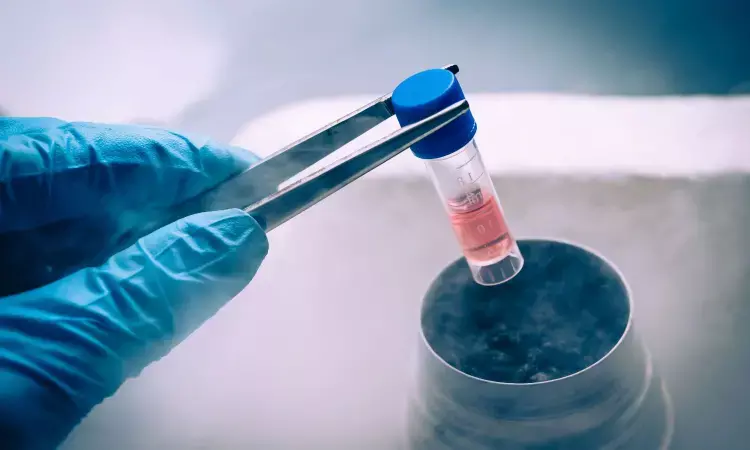- Home
- Medical news & Guidelines
- Anesthesiology
- Cardiology and CTVS
- Critical Care
- Dentistry
- Dermatology
- Diabetes and Endocrinology
- ENT
- Gastroenterology
- Medicine
- Nephrology
- Neurology
- Obstretics-Gynaecology
- Oncology
- Ophthalmology
- Orthopaedics
- Pediatrics-Neonatology
- Psychiatry
- Pulmonology
- Radiology
- Surgery
- Urology
- Laboratory Medicine
- Diet
- Nursing
- Paramedical
- Physiotherapy
- Health news
- Fact Check
- Bone Health Fact Check
- Brain Health Fact Check
- Cancer Related Fact Check
- Child Care Fact Check
- Dental and oral health fact check
- Diabetes and metabolic health fact check
- Diet and Nutrition Fact Check
- Eye and ENT Care Fact Check
- Fitness fact check
- Gut health fact check
- Heart health fact check
- Kidney health fact check
- Medical education fact check
- Men's health fact check
- Respiratory fact check
- Skin and hair care fact check
- Vaccine and Immunization fact check
- Women's health fact check
- AYUSH
- State News
- Andaman and Nicobar Islands
- Andhra Pradesh
- Arunachal Pradesh
- Assam
- Bihar
- Chandigarh
- Chattisgarh
- Dadra and Nagar Haveli
- Daman and Diu
- Delhi
- Goa
- Gujarat
- Haryana
- Himachal Pradesh
- Jammu & Kashmir
- Jharkhand
- Karnataka
- Kerala
- Ladakh
- Lakshadweep
- Madhya Pradesh
- Maharashtra
- Manipur
- Meghalaya
- Mizoram
- Nagaland
- Odisha
- Puducherry
- Punjab
- Rajasthan
- Sikkim
- Tamil Nadu
- Telangana
- Tripura
- Uttar Pradesh
- Uttrakhand
- West Bengal
- Medical Education
- Industry
Groundbreaking Study Reveals Best Protocol for Frozen Embryo Transfer in High Ovarian Response Women

China: In a landmark study published in the prestigious journal Fertility and Sterility, researchers have shed light on the most effective protocol for frozen embryo transfer (FET) in women with anticipated high ovarian response. The randomized controlled trial compared the live birth rates between the progestin-primed ovarian stimulation (PPOS) protocol and the antagonist protocol, both commonly used in assisted reproductive technology (ART) procedures.
The study found comparable live birth rates of the first FET following the PPOS and antagonist protocols in women with an anticipated high ovarian response.
The PPOS protocol involves the administration of progestins before ovarian stimulation, aiming to reduce the risk of ovarian hyperstimulation syndrome (OHSS) while promoting endometrial receptivity. On the other hand, the antagonist protocol involves the use of gonadotropin-releasing hormone antagonists to prevent premature ovulation during ovarian stimulation.
Ernest Hung Yu Ng, The University of Hong Kong, People’s Republic of China, and colleagues aimed to compare the live birth rate of the first frozen embryo transfer after ovarian stimulation by the progestin-primed ovarian stimulation protocol versus the antagonist protocol in women with an anticipated high ovarian response undergoing in vitro fertilization.
For this purpose, the researchers conducted a randomized controlled trial at a tertiary assisted reproduction center. It included women with infertility aged <43 years undergoing the first in vitro fertilization cycle and having antral follicle count of >15.
10 mg medroxyprogesterone was given daily from the start of ovarian stimulation until the day of ovulation triggered in the PPOS protocol. In the antagonist protocol, an antagonist of 0.25 mg daily was given from the sixth day of ovarian stimulation till the day of ovulation trigger. Blinding was impossible for physicians or women, but the biostatistician was blinded to the group assignment.
The main outcome measure was the live birth rate of the first FET cycle. 784 women were recruited in 2020 and 2021 and assigned randomly in a 1:1 ratio into two groups: the PPOS group comprising 392 women and the antagonist group of 392 women.
The study led to the following findings:
- Embryo transfer was either canceled or postponed in 62 women in the PPOS group and the antagonist group because of no transferable embryos or no FET within six months after randomization.
- The two groups were similar in demographic characteristics and the numbers of oocytes obtained or fertilized, cleaving embryos, good-quality embryos at day 3, blastocysts developed, and embryos or blastocysts were frozen.
- There was no statistically significant difference in the live birth rate of the first FET cycle between the PPOS and antagonist groups based on both the intention-to-treat analysis (37.5.0% versus 32.7%; relative risk, 1.148) and per-protocol analysis (44.5% versus 39.1%; relative risk, 1.138).
- Both groups showed comparable clinical pregnancy, miscarriage, ongoing pregnancy, multiple pregnancy, ectopic pregnancy, and cumulative live birth rates.
In conclusion, the study represents an important contribution to assisted reproduction. Highlighting the progestin potential as an alternative to GnRH antagonists should prompt reflection and discussion among providers and lead to additional high-quality studies of unanswered questions.
"This research should be essential reading for all practitioners involved in ART as we continue to strive for more accessible, safer, and more effective treatments for infertility," the researchers wrote.
Reference:
Chen, Z. Q., Ai, A., Zhang, Y., Li, H., Wang, J. Y., Wang, L., & Ng, E. H. Y. (2024). A randomized controlled trial to compare the live birth rate of the first frozen embryo transfer following the progestin-primed ovarian stimulation protocol vs. The antagonist protocol in women with an anticipated high ovarian response. Fertility and Sterility, 121(6), 937-945. https://doi.org/10.1016/j.fertnstert.2024.01.027
Dr Kamal Kant Kohli-MBBS, DTCD- a chest specialist with more than 30 years of practice and a flair for writing clinical articles, Dr Kamal Kant Kohli joined Medical Dialogues as a Chief Editor of Medical News. Besides writing articles, as an editor, he proofreads and verifies all the medical content published on Medical Dialogues including those coming from journals, studies,medical conferences,guidelines etc. Email: drkohli@medicaldialogues.in. Contact no. 011-43720751


